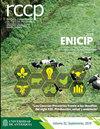基于典型相关分析的牛肉pH值、皮下脂肪厚度和颜色之间的多变量关系
IF 0.5
4区 农林科学
Q4 AGRICULTURE, DAIRY & ANIMAL SCIENCE
引用次数: 1
摘要
背景:pH值、皮下脂肪厚度(SFT)和颜色是确定肉类感官特征的基本变量。然而,这些性状的多变量关系在牛肉中仍未得到探索。目的:应用典型相关分析法研究牛肉pH值、皮下脂肪厚度和颜色参数之间的多变量关系。方法:构建了一个数据集,包含来自五种巴西牛肉切片类型(品种:Nellore;切片:acém、contrafilé、fraldinha、patinho和picanha)的173个pH、SFT和颜色参数(A*:红色强度,b*:黄色强度,L*:亮度)的个体记录。使用SAS的CANCORR程序探讨了颜色变量(a*、b*和L*)和化学变量(pH和SFT)之间的多变量关系。结果:U(a*、b*和L*;颜色变量)和V(pH和SFT;化学变量)变量之间的两个典型相关性显著(p<0.01)。第一和第二典型相关性分别为0.463和0.282。变量的标准权重为U1:a*=0.707,b*=0.406,L*=0.039;U2:a*=0.364,b*=0.898,L*=1.234;V1:pH=-0.376,SFT=0.935;V2:pH=0.927,STF=0.356。结论:皮下脂肪厚度显著影响红、黄颜色的强度,而pH值显著影响亮度。这项研究的结果可能有助于更好地理解肌肉代谢的作用及其对牛肉感官特征的影响。本文章由计算机程序翻译,如有差异,请以英文原文为准。
Multivariate relationship among pH, subcutaneous fat thickness, and color in bovine meat using canonical correlation analysis
Background: pH, subcutaneous fat thickness (SFT), and color are fundamental variables to define the organoleptic characteristics of meat. However, multivariate relationships of those traits remain unexplored in bovine meat. Objective: To investigate the multivariate relationships among pH, subcutaneous fat thickness, and color parameters in bovine meat using canonical correlation analysis. Methods: A dataset containing 173 individual records of pH, SFT, and color parameters (a*: intensity of red color, b*: intensity of yellow color, and L*: lightness) from five Brazilian beef cut types (Breed: Nellore; cuts: acém, contrafilé, fraldinha, patinho and picanha) was constructed. Multivariate relationships between color variables (a*, b*, and L*) and chemical variables (pH and SFT) were explored using the CANCORR procedure of SAS. Results: Two canonical correlations between U (a*, b*, and L*; color variables) and V (pH and SFT; chemical variables) variates were significant (p<0.01). First and second canonical correlations were 0.463 and 0.282, respectively. Canonical weights for variates were for U1: a* = 0.707, b* = 0.406, and L* = -0.039; U2: a* = 0.364, b* = -0.898, and L* = 1.234; V1: pH = -0.376 and SFT = 0.935; V2: pH = 0.927 and STF = 0.356. Conclusion: Subcutaneous fat thickness significantly affected intensity of red and yellow colors, whereas pH significantly affected lightness. The results of this study may be useful for a better understanding of the role of muscle metabolism and its implications on the organoleptic characteristics of bovine meat.
求助全文
通过发布文献求助,成功后即可免费获取论文全文。
去求助
来源期刊

Revista Colombiana De Ciencias Pecuarias
AGRICULTURE, DAIRY & ANIMAL SCIENCE-
CiteScore
0.80
自引率
0.00%
发文量
18
审稿时长
6-12 weeks
期刊介绍:
The editors of Revista Colombiana de Ciencias Pecuarias (RCCP) welcome the submission of original manuscripts on experimental and clinical studies associated with the broad areas of animal sciences and veterinary medicine as they interface with biochemistry, molecular biology, physiology, pharmacology, toxicology, pathology, microbiology, parasitology, immunology and epidemiology. The scope of the journal includes studies of basic and applied research in animal management and production, feeding and nutrition, reproduction, breeding, genetics, animal welfare and behavior; as well as animal production focussed from biotechnology, soil science, agrostology, silvopastoral systems, livestock economics and the environment.
The criteria for acceptance of papers submitted for publication are originality, quality and clarity of the content. Each contribution must be based on original, unpublished research that has not been simultaneously submitted to other journals. All papers will be peer reviewed. All authors bear responsibility for ensuring the integrity and quality of their reported research. It is the author''s responsibility to secure permission to use figures or tables that have been published elsewhere.
Contributions may be classified as original research, review, rapid communication, clinical case studies or methodological articles, as well as news/commentaries or letters to the editor. Most review articles are invited by the editor. Authors interested in submitting a review article should contact the corresponding editor. Rapid publication of original manuscripts is a goal of the journal. Manuscripts must be written in English. Each manuscript is considered for publication with the understanding that it has not been simultaneously submitted to any other journal. Upon acceptance for publication, papers are subject to editorial review and revision.
 求助内容:
求助内容: 应助结果提醒方式:
应助结果提醒方式:


